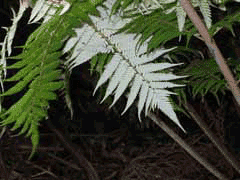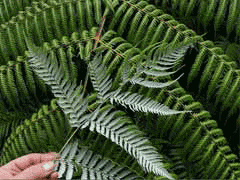 |
|
|
 |
| http://commons.wikimedia.org/wiki/User:Kahuroa |
Translate this page:
Summary
Physical Characteristics

 Cyathea dealbata is an evergreen Fern growing to 9 m (29ft) by 2 m (6ft).
Cyathea dealbata is an evergreen Fern growing to 9 m (29ft) by 2 m (6ft).
See above for USDA hardiness. It is hardy to UK zone 9 and is frost tender. It is in leaf all year.
Suitable for: light (sandy), medium (loamy) and heavy (clay) soils. Suitable pH: mildly acid, neutral and basic (mildly alkaline) soils. It can grow in full shade (deep woodland) or semi-shade (light woodland). It prefers moist or wet soil.
UK Hardiness Map
US Hardiness Map
Synonyms
Plant Habitats
Woodland Garden Dappled Shade; Shady Edge; not Deep Shade; Bog Garden;
Edible Uses
Edible Parts: Leaves Stem
Edible Uses:
Pith of the stem[2, 46, 61, 105]. Rich in starch, it is normally roasted but can be eaten raw[193]. Descriptions of the taste vary from bitter, sweet, astringent and like a bad turnip[193]. The core of the plant near the growing tip is used[193], do not confuse this with the trunk of the plant, which is made up of a peaty substance from the decaying roots[K]. Harvesting the stem kills the plant so this use cannot normally be condoned[193]. Young leaves - cooked. Harvested just before they unfurl, they are juicy and slimy, tasting like bitter celery[193].
References More on Edible Uses
Medicinal Uses
Plants For A Future can not take any responsibility for any adverse effects from the use of plants. Always seek advice from a professional before using a plant medicinally.
None known
References More on Medicinal Uses
The Bookshop: Edible Plant Books
Our Latest books on Perennial Plants For Food Forests and Permaculture Gardens in paperback or digital formats.

Edible Tropical Plants
Food Forest Plants for Hotter Conditions: 250+ Plants For Tropical Food Forests & Permaculture Gardens.
More

Edible Temperate Plants
Plants for Your Food Forest: 500 Plants for Temperate Food Forests & Permaculture Gardens.
More

More Books
PFAF have eight books available in paperback and digital formats. Browse the shop for more information.
Shop Now
Other Uses
References More on Other Uses
Cultivation details
Prefers a humus-rich soil in a sheltered light position but with shade from strong sun. It grows well in light woodland. Requires shelter from winds, an abundance of moisture at its roots and its trunk kept wet[1, 49, 200]. A very ornamental plant, it succeeds outdoors in woodland conditions in the mildest areas of the country, but it is tender in most parts of Britain[49]. Members of this genus are rarely if ever troubled by browsing deer[233].
References Carbon Farming Information and Carbon Sequestration Information
Temperature Converter
Type a value in the Celsius field to convert the value to Fahrenheit:
Fahrenheit:
The PFAF Bookshop
Plants For A Future have a number of books available in paperback and digital form. Book titles include Edible Plants, Edible Perennials, Edible Trees,Edible Shrubs, Woodland Gardening, and Temperate Food Forest Plants. Our new book is Food Forest Plants For Hotter Conditions (Tropical and Sub-Tropical).
Shop Now
Plant Propagation
Spores - can be surface sown at any time of the year in a light position in a warm greenhouse[164]. Keep moist by standing the pot in shallow water or by enclosing it in a plastic bag. Germinates in 1 - 3 months at 25°c. Prick out patches of the young plants into small pots and stand the pots in shallow water until the plants are well established[164]. Grow on in a shady position in a greenhouse for at least the first two winters and plant out in late spring.
Other Names
If available other names are mentioned here
Native Plant Search
Search over 900 plants ideal for food forests and permaculture gardens. Filter to search native plants to your area. The plants selected are the plants in our book 'Plants For Your Food Forest: 500 Plants for Temperate Food Forests and Permaculture Gardens, as well as plants chosen for our forthcoming related books for Tropical/Hot Wet Climates and Mediterranean/Hot Dry Climates. Native Plant Search
Found In
Countries where the plant has been found are listed here if the information is available
Weed Potential
Right plant wrong place. We are currently updating this section.
Please note that a plant may be invasive in one area but may not in your area so it’s worth checking.
Conservation Status
IUCN Red List of Threatened Plants Status :

Growth: S = slow M = medium F = fast. Soil: L = light (sandy) M = medium H = heavy (clay). pH: A = acid N = neutral B = basic (alkaline). Shade: F = full shade S = semi-shade N = no shade. Moisture: D = dry M = Moist We = wet Wa = water.

Expert comment
Author
(G.Forst.)Swartz.
Botanical References
44200
Links / References
For a list of references used on this page please go here
Readers comment
© 2010, Plants For A Future. Plants For A Future is a charitable company limited by guarantee, registered in England and Wales. Charity No. 1057719, Company No. 3204567.